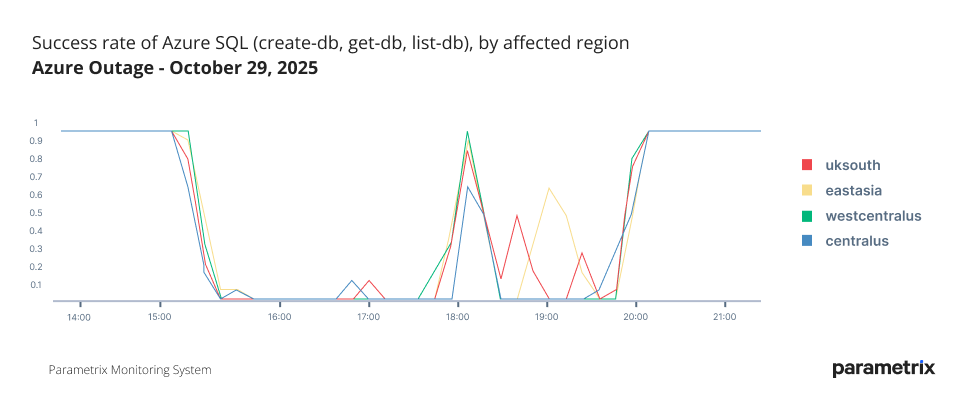On October 29, 2025, Microsoft Azure experienced a significant disruption stemming from an accidental configuration change in Azure Front Door (AFD), Microsoft’s Content Delivery Network (CDN) service. The event lasted from 15:45 UTC on October 29 until 00:05 UTC on October 30, affecting users and numerous services worldwide.
Because AFD operates at the internet edge, the misconfiguration led to widespread latency, timeouts, and connection errors across public web endpoints. The primary effect was a reduction in the availability of websites and web applications, causing slow load times, intermittent 4xx/5xx responses, and portal sign-in issues for end users.
Parametrix monitors real-time service availability for 7,000+ SaaS, PaaS, and IaaS providers. During the 29 Oct Azure incident, around 12% of monitored providers showed disruptions of varying severity. That footprint is roughly one-third of what we observed during the AWS us-east-1 outage 10 days earlier. On a pure exposure basis - i.e., scope of usage and number of companies affected, excluding financial impact - the Azure event had lower overall exposure than the AWS us-east-1 incident. This highlights how concentrated dependencies on us-east-1 can create outsized, ecosystem-wide effects.

Affected services & dependencies
Primary dependency:
Many control-plane and data-plane endpoints across Azure are fronted by Azure Front Door. When AFD degraded, any service/app relying on its routing and CDN edge experienced elevated error rates.
Azure & Microsoft services called out by Microsoft:App Service, Azure SQL Database, Azure Portal, Container Registry, Media Services, Azure Communication Services, Azure Databricks, Azure Maps, Azure Virtual Desktop, Video Indexer, Microsoft Entra ID / AAD B2C (identity & access mgmt UX), Microsoft Defender External Attack Surface Mgmt, Microsoft Purview, Microsoft Sentinel (Threat Intelligence), Microsoft 365
Notable customer/industry impact
- Airlines / Travel: Alaska Airlines (check-in & sites), Hawaiian Airlines, Air New Zealand (payments/boarding passes) affected; Heathrow Airport site impacted.
- Telecom: Vodafone UK reported issues.
- Retail / Consumer: Starbucks, Costco, Kroger websites/apps had problems.
- Financial services: Users reported issues at Capital One aligned with the Azure incident window.
- Gaming: Xbox
Parametrix monitoring:
Parametrix detected an interruption in the three specific management operations of SQL Database in four regions: centralus, eastasia, uksouth, westcentralus, from 15:48 to 20:11 UTC. The most errors were: Code: ServerUnableToRetriveData.

This is expected given Azure’s architecture. Those operations run on the control plane, which is exposed to the internet through Azure Front Door (AFD). During the incident, degraded AFD nodes caused intermittent routing failures and timeouts for management APIs - even if the underlying data plane (actual SQL database connectivity/queries) remained healthy. The uneven regional effect (centralus, eastasia, uksouth, westcentralus) reflects traffic being redistributed away from unhealthy edge nodes, creating region-specific pockets of unavailability rather than a uniform global failure. The error “ServerUnableToRetriveData” aligns with this pattern: it’s a generic upstream failure/timeout surfaced by the SQL resource provider when it cannot retrieve state from backend services due to transient control-plane outages. In short, we observed downstream symptoms of an AFD-edge issue without monitoring AFD directly, because our management calls traverse that same edge path.


.svg)

